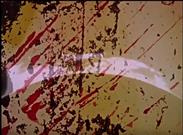|
|
||||
|
|
by Richard Jack Smith  If Dog Star Man was intended to represent mankind's consciousness, we are given precious little to think about. In the 1960s, psychedelic experiences were the norm. Friends would gather under a bridge or near a campfire, tell stories, have a quick tote and let their imaginations fly. Cinematically, there were highlights which catered to the LSD crowd. Consider the "Star Gate" sequence in Stanley Kubrick's 2001: A Space Odyssey. For a drug addled brain, this experience could be transcendent. By contrast, any sensible thinking person would regard such indulgence as folly. So it goes for Dog Star Man. It's like a novice being given a camera. They film anything they desire then make a hash in the editing room. Opticals bleed and overlap. There are scratches all over the frame like a dog decided to eat the work in progress. The transitions between sun flares, moonscapes, climbing, arms, faces, breasts and other elements appear so perfunctory as to be meaningless. Trees shake, forms defocus, shadows thrash and very little makes sense. Although the film plays silent, that's one less way for it to be irritating. Those with an aversion to blurriness, murkiness, fuzziness and jumpiness would do well to avoid Stan Brakhage's art film. Actually, Dog Star Man came to my attention via a YouTube video entitled "Top 5 Most Original Movies of all Time." Gosh, no Being John Malkovich or Memento? I'd settle for Eternal Sunshine of the Spotless Mind. Anyway, Brakhage's film earned the top spot, which makes me question whether Cinefix - IGN Movies and TV have ever looked up the definition of the word 'original.' Despite traditional chapter markers such as "Prelude," "Part 1" and "The End," the film operates like a Jackson Pollock drip painting in motion. There's a pseudo sexual undercurrent via nudity. How novel. There's snow too, perhaps representing Christmas or deepest winter. As for colour, there are so many hues and shades slammed over the lens yet Brakhage does nothing with them. These elements were chosen for convenience, which makes such indulgence all the more perplexing. While older films normally undergo painstaking restoration efforts to remove scratches, Brakhage revels in them. He wields the menacing floaters as a new paintbrush, held the wrong way. As such, Dog Star Man comes across as an ugly, irredeemable artistic failure; a butterfly view on randomly jumbled sights without the context to resonate nor the narrative hook to become immersive. Craftsmanship doesn't exist here. Despite the initial clarity, "Part 1" eventually succumbs to generic handheld camerawork. Also, there are plenty of black screens in this wallowing mess which hurts the eyes, while offending the need for tidiness. The camera rarely rests and the editing makes it even worse. Overall, Dog Star Man felt like an easy picture to explain yet an impossible one to recommend. |
||
|
© 2025 - ReelTalk Movie Reviews Website designed by Dot Pitch Studios, LLC |



